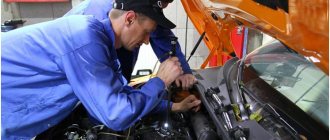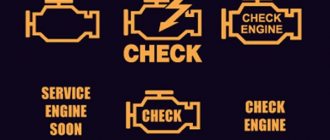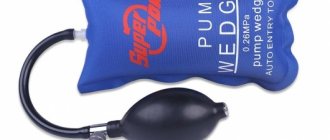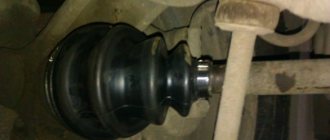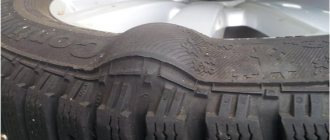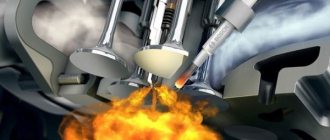About the Car ⁄ Theory and driving skills ⁄
On the bumpy roads of Russia, puncturing a tire by running into a hole or running into a foreign object lying on the road is as easy as shelling pears. It's one thing when you're driving at low speed, blow out a tire and immediately stop, but it's quite another thing when the tire blows out while driving at high speed. Many drivers believe that this situation is almost hopeless, since the car immediately loses stability, it is pulled to the side and, if not thrown off the road, or does not overturn at all. But experts assure that even in such a dangerous and hopeless situation as it may seem at first glance, you can regain control of the car and stop it without consequences. We will talk about how to do this in the article.
What to do if a tire is punctured due to a hole
Is a car falling into a pothole an accident?
Initially, it is necessary to determine the legal side of the concept of “falling into a hole.”
According to clause 1.2 of the Traffic Rules, a traffic accident is an event that occurs during the movement of a car on the road or with its participation, resulting in death or injury to people, damage to vehicles, buildings, cargo, or provoked the infliction of other types of material damage.
Considering that the car was moving along the road before falling into a hole, and after that it suffered and received mechanical damage, then falling into a hole is considered an accident (RTA).
In order to record the damage received, it is necessary to call representatives of the traffic police, and not the local police officer, as when snow falls.
In most cases, when a car owner crashes into a hole and punctures a tire or damages a disc, he repairs the damage with a jack or spare wheel, not even knowing that the organization responsible for repairing this track can be made to pay for the damage received.
In certain cases, the car owner can count on payment of compensation for damage caused.
The current GOST stipulates that the dimensions of the pit should be: no more than fifteen centimeters in length, sixty in width and five in depth. Exceeding the established dimensions, lack of fences or installed signs is grounds for payment of compensation to the victim.
If an unfortunate hit by such a hole ends disastrously for the wheels or suspension of your vehicle, then you should proceed as follows:
- It is necessary to mark the car on the roadway: to do this, turn on the headlights to the emergency lights and put up a forced stop sign. Next, you should wear a reflective vest (a good driver always has such a vest in the trunk along with a fire extinguisher and an emergency stop sign);
- Call the traffic police representatives to the scene of the accident;
- The traffic police representatives who arrived at the scene of the accident are required to draw up an inspection report of the road surface and provide the victim with a certificate of the accident. In this certificate, government officials indicate information about identified road defects;
- If you have a video recorder, you must save a recording of the moment you hit the hole. In addition, you can additionally photograph potholes and defects that remain after falling into the pit. In the event of a trial, these photographs will serve as evidence that the damage to the car was caused due to defects in the road surface;
- After this, it is necessary to obtain copies of documents from the traffic police to present to the road organization and receive further compensation for the cost of repairs. The details of the organization that is responsible for each section of the roadway are located in the traffic control service of the State Traffic Safety Inspectorate. In addition, if desired, a statement can be made to the prosecutor’s office. This statement states demands to bring the organization responsible for roads to administrative responsibility for failure to comply with the provisions of Article 12.34 of the Code of Administrative Offenses of the Russian Federation, namely, failure to comply with the requirements provided for ensuring safe traffic on the roads during the repair and maintenance of these roads, railway crossings or other structures on roads. Penalties provided for violation of the requirements established by this article range from 2 to 3 thousand rubles for officials, and 300 thousand for legal entities;
- After completing the previous stages, the car owner needs to contact an expert organization to assess the damage caused to the vehicle. Before carrying out the assessment, it is necessary to notify the road organization about the place and time of the expert procedures. If the guilty party ignores the specified event, this fact does not affect anything. The main thing is to obtain the results of the examination;
- The final stage involves collecting all documents and sending a letter to the road organization with an offer to voluntarily compensate for the damage caused. If after a month the road organization has not provided an answer and denies responsibility for the accident, the injured party has the right to go to court.
It is possible to recover from the defendant not only material compensation, but also compensation for moral damage caused to health, and compensation for costs associated with the inability to use his car (for example, renting other vehicles, using a taxi service).
What to do if you are accused of an accident that you did not commit?
What to agree to under compulsory motor liability insurance: money or repairs, read here.
What to do if the insurance company delays payment, read the link:
Is everything so bad
You may be able to get away with a small loss of time and money if the puncture is minor. Most wheels are equipped with tubeless tires, which do not immediately deflate in case of minor punctures. You can drive to the nearest gas station, pump up the tire and head towards the nearest tire shop. However, some gas stations offer a tire service, and you won’t have to travel far.
If the puncture results in a nail or self-tapping screw that remains inside the tire, you should not remove it. Perhaps it is this foreign object that prevents the tire from deflating quickly. And this can happen as soon as you remove the ill-fated piece of iron.
You can also patch a small puncture using a sealant designed for short-term wheel repairs. It will plug the puncture and also create the necessary pressure in the tire.
When you find that the tire is completely flat, the methods described do not make much sense.
Here we will have to act in other ways.
Preparation of documents if you get into a pothole on the road
In order to receive money from the road company for restoring the vehicle, you should be careful about the procedure for registering an accident. A positive court decision is only possible if full evidence of the circumstances of the accident has been collected.
If you fall into a pothole, it is impossible to independently register a traffic accident, since there is only one car involved in the accident. The first thing you need to do is call the traffic police.
Before the patrol arrives, you can independently collect evidence of the accident:
- If there are witnesses, it is important to have time to record their testimony. As a rule, people quickly leave the scene of an accident, therefore, if they hesitate, it will be impossible to find them;
- It is advisable to take photographs of the accident scene. These photographs must clearly show:
- The address where the accident occurred (you need to take a photo of the car against a background where you can see a sign with the name of the street and house);
- State registration plate of the car;
- Noticeable damage to the machine;
- The culprit of the accident is a hole or pothole;
- Lack of safety signs that would warn of an accident.
After you have photographed the necessary details of the accident, you should wait for the patrol to arrive to complete the documentation.
When a traffic police representative registers an accident, you must ensure that he records the hole and its dimensions on the diagram. It is also important to establish the absence of signs and fences.
It is important to take into account that the standards of GOST 50597-93, which indicate the parameters regarding the condition of roads and streets that are acceptable to ensure safe road traffic, clearly regulate the requirements for the size of holes on the roadway:
3.1. Road surface covering.
3.1.2. The size limits for individual subsidence, potholes, etc. cannot be more than fifteen centimeters in length, sixty centimeters in width and five centimeters in depth.
When a car is damaged in a hole that does not correspond to these dimensions, the chances of a positive result in court against the road organization increase.
No jack or tools
There are situations when a spare tire is available, but you forgot to buy a jack or simply put it away as unnecessary. In this situation, you will need outside help.
It’s good if the puncture occurred in an area where you have many friends, you can call them and they will come to the rescue. If your friends are busy or a puncture occurs on a country road, you will have to take the pose of a voter in the expectation that one of the drivers will stop to help you.
There is another option - call a taxi, having first told the dispatcher about your problem
. Surely, any taxi driver in the trunk will have the necessary list of tools and a jack, which are so necessary in case of a puncture.
Who to sue if you break a tire on the road
Initially, it is necessary to establish an organization that services the section of the road that caused the accident. This information is available to representatives of the traffic police who carry out the registration of the accident.
The traffic police representative issues a protocol to the road organization, referring to Article 12.34 of the Code of Administrative Offenses, and the judge applies a fine determined by law.
Article 12.34 of the Code of Administrative Offenses provides for sanctions for failure to comply with the requirements established for road safety during construction, repair and maintenance of the roadway, as well as crossings on railways or other structures.
Sanctions are also imposed for failure to take measures to timely eliminate obstacles to traffic on the roads, for failure to temporarily restrict or stop traffic on certain sections of roads when their use threatens road safety.
These actions involve the application of administrative fines to officials responsible for the condition of the road surface, crossings or other structures on the roads, in the amount of 20 thousand to 30 thousand rubles; and to legal entities - in the amount of two hundred thousand to three hundred thousand rubles.
However, the driver should find out the details of the institution responsible for the condition of the roadway, and not the very fact of applying penalties.
Money issue
Of course, when stopping your car to borrow a jack or repair kit, be prepared to pay a certain amount. 5-10 dollars will be enough depending on the degree of assistance provided. You may come across a noble driver who won’t ask for a fee, but, as practice shows, there are fewer and fewer of them. By the way, you can try to buy a spare tire from the stopped driver if you don’t have one.
How much will it cost to repair a flat tire?
Tire technicians will perform a free puncture inspection and then issue a verdict. Repairing a tire damaged on the side will cost $10-20. A patch is installed there, and the tire can serve for some time as a spare. A puncture in the center of the tire will cost a little less - up to $15. A special tourniquet is installed at the puncture site, which creates a vacuum and prevents air from escaping from the tire.
Spare or repair
Of course, if the car has an inflated spare tire, a safety jack and a set of tools, the process of replacing a bad tire will not take much time. Your algorithm of actions is as follows:
- Turn off the engine and put the car in gear so that it does not roll away.
- For safety reasons, place stones under intact wheels.
- Use a jack and lift the part of the car with the flat tire.
- Unscrew the bolts securing the wheel to the hub, first removing the discs, if any.
- Install the new wheel onto the hub, carefully tightening the mounting bolts.
- Lower the car using a jack and remove stones from under the remaining wheels.
If you have a small compressor or mechanical pump, pump up the supplied tire and move on. It is advisable to take the removed punctured wheel immediately to a tire shop in order to have the tire repaired as soon as possible, if possible.
If you have deep punctures or a cut on the side of the tire, you will most likely have to get rid of it and get a new spare tire.
Repairing tire punctures using improvised means from the store in order to get to the tire shop
Let's look at 2 ways to “treat” tire punctures using products that can be bought in the store. The important thing is that, with some skill, they can be used without removing the damaged wheel from the car. BUT BEFORE THIS, a little “life hack”. To repair a puncture, it still needs to be detected. For this, a regular soap solution is suitable, which can be poured, for example, into a container of some household chemicals with a spray bottle (such a container will not take up much space in the trunk, so it can “travel” with you all the time). It’s simple: we spray the surface of the wheel and look for the puncture site based on the appearance of characteristic air bubbles. AND SO THAT THE SOLUTION DOES NOT FREEZE in winter, you can simply mix it with “anti-freeze”, as many experienced motorists do.
The first method is tire repair sealant.
It is a special composition “blown out” into a can under pressure. Today you can buy such a product in almost any auto store and at many gas stations. How does he work? It's quite simple: you attach the cylinder to the wheel valve (directly or using an adapter), press the sprayer, and voila: the “magic” happens. The vast majority of such sealants offered for sale, in addition to sealing a puncture (the composition is distributed over the inner surface of the tire), also increase pressure. The MAIN THING is to read the instructions (no matter how clunky it may seem) and do everything according to it. And you will be happy: you can slowly drive to the tire shop (as a rule, it is recommended to drive at a speed of no more than 70 km/h). By the way, such sealants are also produced in containers in which they are not placed under pressure (for example, a standard repair kit that was equipped with VAZ cars at the end of the last century). But this type is gradually being replaced by aerosol sealants, which are more convenient to use, because... They allow you to “eat a fish and sit on a bone”: repair the damage and pump up the tire.
When using such compositions, it is important to pay attention to a number of points:
- Select the correct container for the repair aerosol. If you have a car with wheels up to “15 in diameter,” 300 ml should be enough. Owners of crossovers and SUVs are recommended to choose a larger capacity.
- Pay attention to the temperature range of use of the composition. Many imported aerosols (and most of those sold are imported) are not adapted to the low temperatures that occur in our “realities”.
- If it says on the can. The fact that the wheel should not be inflated after applying the compound means that this REALLY SHOULD NOT be done. The fact is that some of the compounds are flammable, and neglecting the manufacturer’s recommendations can lead to not entirely pleasant consequences.
- When visiting a tire shop to repair a tire “reanimated” in this way, be sure to warn the specialist about the use of sealant. In most cases, before starting to repair the damage, it is necessary to thoroughly clean the surface of this composition.
- Most of these compounds are designed for use in tubeless tires. But there are also options that can be used for tube tires.
By the way, in addition to repair sealants for tires, preventive ones are also available for sale. They are also “blown” through the wheel valve, and, evenly distributed over the inner surface of the tire, seal microcracks, which are potential weak points.
.
The second method is to repair punctures using flagella
Repair kits are available for sale, which include the following items:
- Flagella.
- A device (also called a file) for expanding/processing a hole.
- A mandrel with which the flagellum is installed.
- Special adhesive composition (it may not be present if the flagella are already impregnated with glue).
- Scissors for cutting off excess cord.
The process of repairing a puncture using this kit is also quite simple. To do this, use a file to develop (expand) a hole. Then a flagellum is inserted into the mandrel, which is driven into the “hole” of the mandrel (if necessary, the adhesive composition from the kit is added). With a sharp movement, the mandrel is removed, and the excess flagellum is cut off (leaving the ends approximately 3-5 mm long). In principle, that's it, you can go. Again, you should be careful and move at low speed. A significant advantage of such a kit is its “reusability”. Having bought a file, a mandrel and scissors once, in the future you will only need to spend money on flagella and adhesive, which are inexpensive.
Instead of output
It can be seen that there are many ways to eliminate tire damage on the road. But not all of them can be used by every motorist. Before resorting to the drastic measures discussed, weigh all the pros and cons. Or maybe, in some cases, it makes sense to catch a ride and take the wheel to the nearest tire shop, or call a tow truck. And sometimes you can even slowly “hobble” on flat tires to the repair site, after which you can throw them away by buying second-hand tires at a tire shop (any workshop has them). In general, the choice is yours. If there is an opportunity (and desire) to make repairs on the road, then why not take advantage of it? Good luck on (and off) the roads, and I hope you don't have to put these methods into practice.
